Small 6’x4′ Greenhouse Layouts Focused on Vegetables
When planning your greenhouse layout, the first step is deciding what you want to grow. Whether it’s vegetables, flowers, or a mix of both, your choices will shape the entire design. Let’s explore how different crops influence the layout and what you need to consider for an efficient and productive greenhouse.
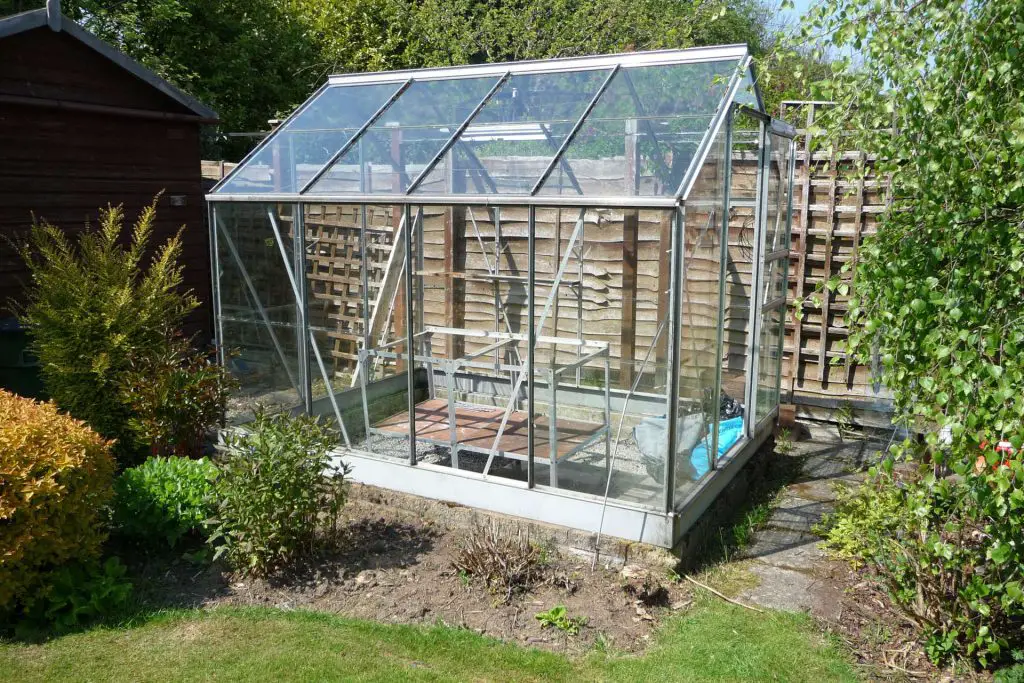
Layout Focused on Vegetables
Designing a layout for a small 6’x4′ greenhouse with a focus on vegetables requires careful use of vertical space and strategic placement of plants. This approach ensures you maximize your growing area while maintaining easy access for care and harvesting.
Floor Plan Overview
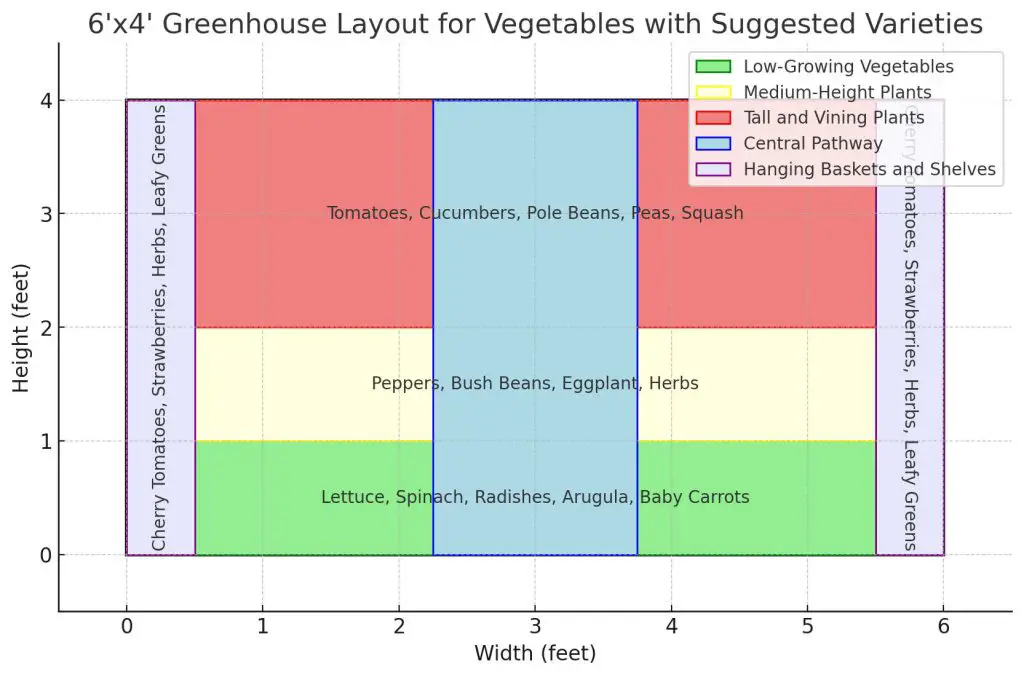
Front Section (Near the Door)
- Low-Growing Vegetables: Place low-growing vegetables such as lettuce, spinach, and radishes near the entrance. These plants require less vertical space and are easy to reach.
- Containers and Raised Beds: Utilize shallow containers or small raised beds to organize these crops efficiently.
Middle Section
- Medium-Height Plants: Use this area for medium-height plants like peppers and bush beans. Position these plants in medium-sized containers or raised beds.
- Vertical Trellises: Install trellises along the sides for plants that can benefit from vertical support, such as peas and beans.
Back Section (Far End)
- Tall and Vining Plants: The back section is ideal for tall and vining plants like tomatoes and cucumbers. Use large pots or deep raised beds to provide ample space for root growth.
- Vertical Growing Systems: Implement vertical growing systems such as stacked pots or tiered shelving to take advantage of the height. Ensure these structures are sturdy and can support the weight of mature plants.
Side Walls
- Hanging Baskets: Use the side walls to hang baskets for smaller vegetables like cherry tomatoes or herbs. This not only saves ground space but also adds an additional layer of planting.
- Wall-Mounted Shelves: Install shelves on the walls to hold seedling trays or smaller pots. These shelves should be adjustable to accommodate different plant heights as they grow.
Pathways and Accessibility
- Central Pathway: Leave a narrow central pathway, about 18 inches wide, to ensure easy access to all plants. This pathway allows you to water, prune, and harvest without stepping on the growing area.
- Rotating Plants: Plan to rotate crops seasonally to maintain soil health and maximize productivity. Use mobile containers to make rotation easier in such a small space.
Lighting and Ventilation
- Natural Light: Ensure the greenhouse gets plenty of natural light by keeping the structure clean and positioning it to receive maximum sunlight throughout the day.
- Ventilation: Install vents or fans to maintain proper airflow, which is crucial for preventing mold and disease in a densely planted area.
There is no doubt that time spent planning your layout before planting can pay dividends. It can help turn a small 6’x4′ greenhouse into a bountiful harvest machine for enjoying vegetables year-round. If you utilize vertical space and organizing plants based on their growth habits, you can create an efficient and productive growing environment. Remember to maintain clear pathways and adjust your setup as needed to accommodate the changing needs of your plants.
Planting Suggestions
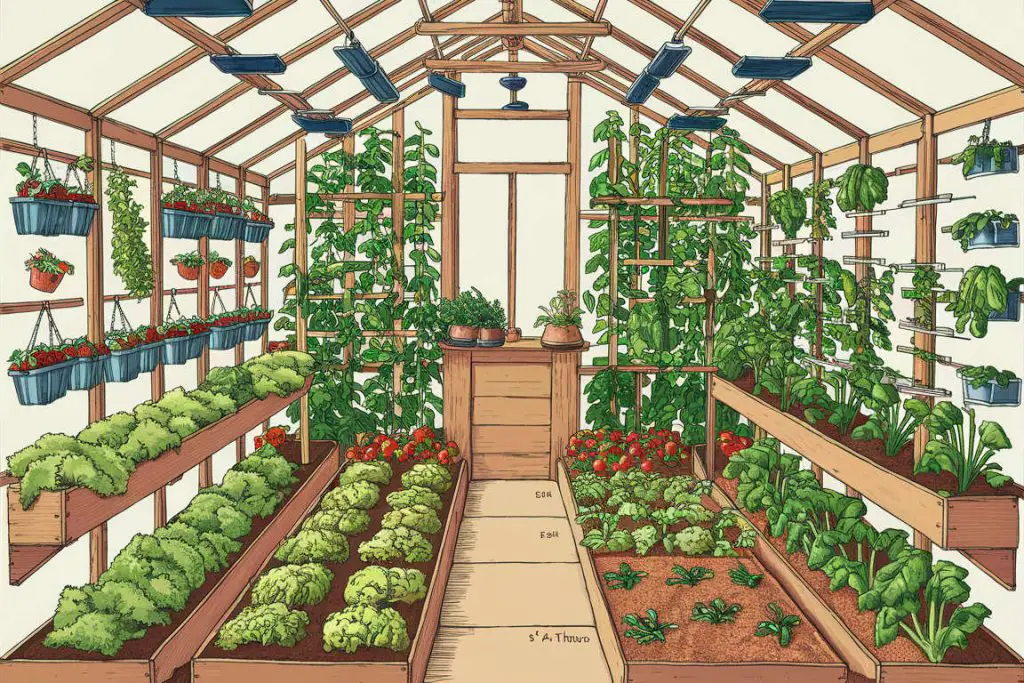
Here are some suitable vegetable varieties for each section of the greenhouse layout:
Front Section (Low-Growing Vegetables)
- Lettuce: Varieties like ‘Butterhead’, ‘Romaine’, and ‘Leaf Lettuce’
- Spinach: ‘Bloomsdale’, ‘Savoy’, and ‘Tyee’
- Radishes: ‘Cherry Belle’, ‘French Breakfast’, and ‘Easter Egg’
- Arugula: ‘Rocket’, ‘Astro’, and ‘Sylvetta’
- Baby Carrots: ‘Thumbelina’, ‘Little Fingers’, and ‘Paris Market’
Middle Section (Medium-Height Plants)
- Peppers: ‘Bell Pepper’, ‘Jalapeño’, and ‘Banana Pepper’
- Bush Beans: ‘Blue Lake’, ‘Contender’, and ‘Provider’
- Eggplant: ‘Black Beauty’, ‘Ichiban’, and ‘Fairy Tale’
- Herbs: ‘Basil’, ‘Parsley’, and ‘Cilantro’
Back Section (Tall and Vining Plants)
- Tomatoes: ‘Cherry Tomato’, ‘Roma’, and ‘Beefsteak’
- Cucumbers: ‘Marketmore’, ‘Armenian’, and ‘Lemon’
- Pole Beans: ‘Kentucky Wonder’, ‘Scarlet Runner’, and ‘Blue Lake Pole’
- Peas: ‘Sugar Snap’, ‘Snow Peas’, and ‘Garden Peas’
- Squash: ‘Zucchini’, ‘Yellow Crookneck’, and ‘Pattypan’
Side Walls (Hanging Baskets and Wall-Mounted Shelves)
- Cherry Tomatoes: ‘Sweet 100’, ‘Sungold’, and ‘Tumbling Tom’
- Strawberries: ‘Albion’, ‘Seascape’, and ‘Ozark Beauty’
- Herbs: ‘Thyme’, ‘Oregano’, and ‘Mint’
- Leafy Greens: ‘Swiss Chard’, ‘Kale’, and ‘Bok Choy’
These varieties are chosen for their suitability to greenhouse growing conditions and their compatibility with vertical gardening techniques. By selecting these types, you can ensure a productive and varied harvest throughout the year.
Layout Focused on Flowers and Plants
Now we will look at creating a layout for a small 6’x4′ greenhouse to focus on flowers and decorative plants involves creating a vibrant and visually appealing space. This layout ensures you can enjoy continuous blooms and lush greenery throughout the year by carefully selecting and organizing your plants.
Floor Plan Overview
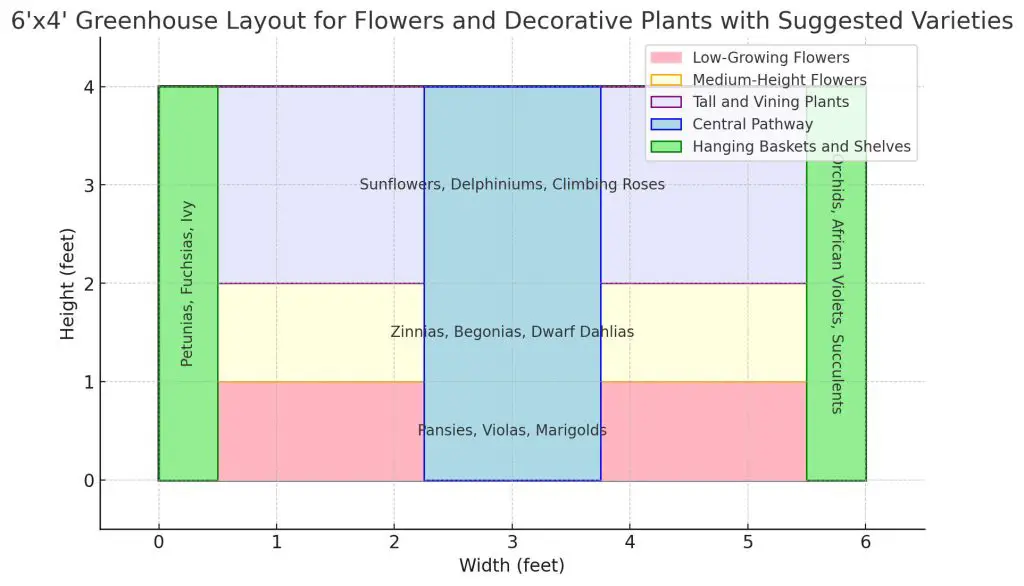
Front Section (Near the Door)
- Low-Growing Flowers: Place low-growing flowers such as pansies, violas, and marigolds near the entrance. These flowers add a burst of color and are easy to maintain.
- Containers and Raised Beds: Use shallow containers or small raised beds to keep these plants organized and easy to reach.
Middle Section
- Medium-Height Plants: This area is ideal for medium-height flowers like zinnias, begonias, and dwarf dahlias. Position these plants in medium-sized containers or raised beds.
- Tiered Shelving: Implement tiered shelving to display these flowers at different heights, creating a visually dynamic space.
Back Section (Far End)
- Tall and Vining Plants: The back section is perfect for tall and vining plants such as sunflowers, delphiniums, and climbing roses. Use large pots or deep raised beds for these plants to thrive.
- Vertical Growing Systems: Install vertical growing systems, such as trellises or obelisks, to support climbing plants and maximize vertical space.
Side Walls
- Hanging Baskets: Utilize the side walls for hanging baskets with trailing plants like petunias, fuchsias, and ivy. This adds a vertical element and frees up bench space.
- Wall-Mounted Shelves: Install adjustable shelves on the walls to hold smaller pots with flowers like orchids, African violets, and succulents.
Pathways and Accessibility
- Central Pathway: Leave a narrow central pathway, about 18 inches wide, to ensure easy access to all plants. This pathway allows you to water, prune, and enjoy your flowers without stepping on them.
- Rotating Plants: Plan to rotate flowers seasonally to maintain a continuous display of blooms. Use mobile containers to make rotation easier in such a small space.
Lighting and Ventilation
- Natural Light: Ensure the greenhouse gets plenty of natural light by keeping the structure clean and positioning it to receive maximum sunlight throughout the day.
- Ventilation: Install vents or fans to maintain proper airflow, which is crucial for preventing mold and disease in a densely planted area.
A well-planned layout for a small 6’x4′ greenhouse can provide a stunning display of flowers and decorative plants year-round. By utilizing vertical space and organizing plants based on their growth habits, you can create a beautiful and enjoyable growing environment. Careful planning ensures that your greenhouse remains a vibrant and welcoming space all year round.
Suitable Flower Varieties for a 6’x4′ Greenhouse
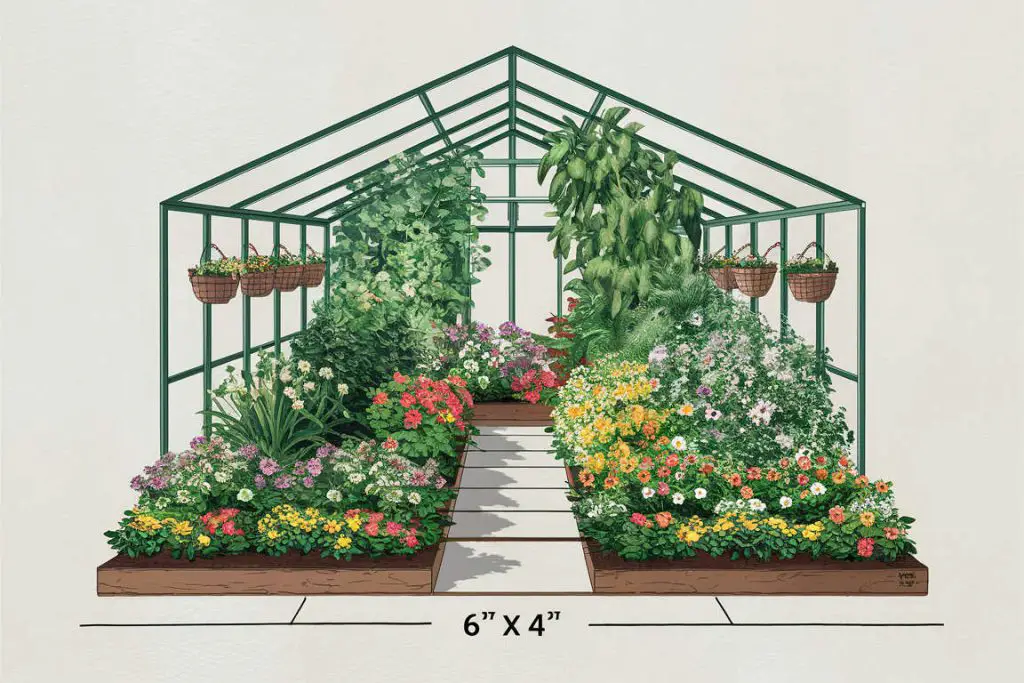
Front Section (Near the Door)
- Pansies: ‘Matrix’, ‘Ultima Morpho’, and ‘Colossus’
- Violas: ‘Johnny Jump Up’, ‘Sorbet’, and ‘Penny’
- Marigolds: ‘French Marigold’, ‘Tagetes’, and ‘African Marigold’
Middle Section
- Zinnias: ‘Profusion’, ‘Zahara’, and ‘Benary’s Giant’
- Begonias: ‘Nonstop’, ‘Dragon Wing’, and ‘Rex’
- Dwarf Dahlias: ‘Gallery’, ‘Figaro’, and ‘Rigoletto’
Back Section (Far End)
- Sunflowers: ‘Mammoth’, ‘Autumn Beauty’, and ‘Velvet Queen’
- Delphiniums: ‘Pacific Giants’, ‘Magic Fountains’, and ‘Guardian’
- Climbing Roses: ‘New Dawn’, ‘Eden’, and ‘Zephirine Drouhin’
Side Walls
- Hanging Baskets:
- Petunias: ‘Wave’, ‘Surfinia’, and ‘Cascadia’
- Fuchsias: ‘Dollar Princess’, ‘Swingtime’, and ‘Blaze’
- Ivy: ‘English Ivy’, ‘Glacier’, and ‘Gold Child’
- Wall-Mounted Shelves:
- Orchids: ‘Phalaenopsis’, ‘Dendrobium’, and ‘Cattleya’
- African Violets: ‘Optimara’, ‘Saintpaulia’, and ‘Chimera’
- Succulents: ‘Echeveria’, ‘Sedum’, and ‘Haworthia’
These varieties are chosen for their adaptability to greenhouse conditions and their ability to thrive in a controlled environment. By selecting these types, you can create a beautiful and diverse display of flowers and decorative plants in your greenhouse.
Final Thoughts
Spending time planning your planting layout for a 6’x4′ greenhouse focused on vegetables or flowers can unlock a world of possibilities for year-round growth. By maximizing vertical space, organizing plants according to their growth habits, and ensuring clear pathways, you can create a thriving and productive environment. Remember to rotate crops seasonally and adjust your setup as needed to accommodate the changing needs of your plants.
With careful planning and attention to detail, your small greenhouse can become a bounty of fresh produce or a stunning display of blooms, providing endless enjoyment and satisfaction.
